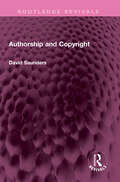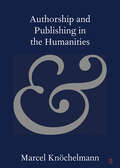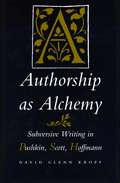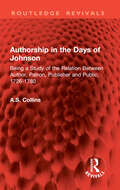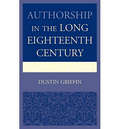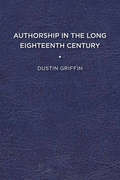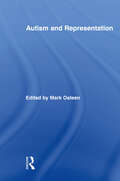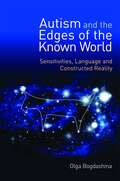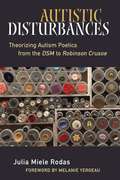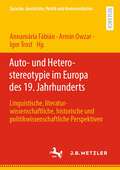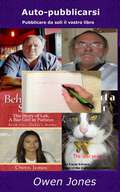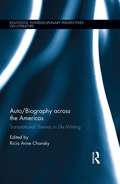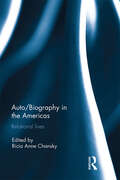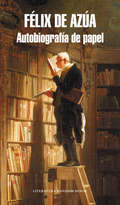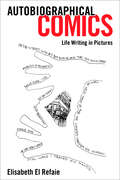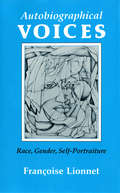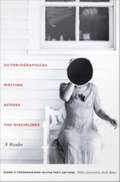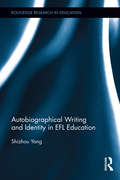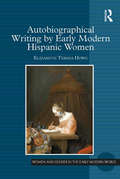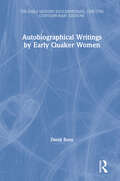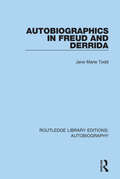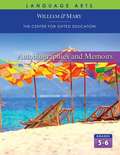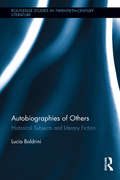- Table View
- List View
Authorship and Copyright (Routledge Revivals)
by David SaundersFirst published in 1992, Authorship and Copyright traces the history of constructions of authorship as a legal reality. It offers an alternative to the two mainstream interpretations that have traditionally been assigned to authorship: the Romantic dialectical ‘birth of the author’ or the language-based post-structuralist ‘death of the author.’ Saunders examines the shortcomings of both schemes by arguing that they impose an arbitrary philosophical direction on the history of authorship and the law of copyright. Saunders addresses the issues relating to copyright and the construction of authorship as a legal status. Combining information and polemic, the author explores such matters as the historical and theoretical relations of copyright and the droit moral, the aestheticization of the law and the juridification of aesthetics, and the argument that authorship as a legal reality is a historically contingent and variable arrangement that cannot be separated from its cultural and juridical context. This book will be of interest to students of law, literature and philosophy.
Authorship and Cultural Identity in Early Greece and China
by Alexander BeecroftIn this book, Alexander Beecroft explores how the earliest poetry in Greece (Homeric epic and lyric) and China (the Canon of Songs) evolved from being local, oral, and anonymous to being textualised, interpreted, and circulated over increasingly wider areas. Beecroft re-examines representations of authorship as found in poetic biographies such as Lives of Homer and the Zuozhuan, and in the works of other philosophical and historical authors like Plato, Aristotle, Herodotus, Confucius, and Sima Qian. Many of these anecdotes and narratives have long been rejected as spurious or motivated by naïve biographical criticism. Beecroft argues that these texts effectively negotiated the tensions between local and pan-cultural audiences. The figure of the author thus served as a catalyst to a sense of shared cultural identity in both the Greek and Chinese worlds. It also facilitated the emergence of both cultures as the bases for cosmopolitan world orders.
Authorship and Publishing in the Humanities (Elements in Publishing and Book Culture)
by Marcel KnöchelmannWhat is the point of publishing in the humanities? This Element provides an answer to this question. It builds on a unique set of quantitative and qualitative data to understand why humanities scholars publish. It looks at both basic characteristics such as publication numbers, formats, and perceptions, and differences of national academic settings alongside the influences of the UK's Research Excellence Framework and the German Exzellenzinitiative. The data involve a survey of more than 1,000 humanities scholars and social scientists in the UK and Germany, allowing for a comprehensive comparative study, and a series of qualitative interviews. The resulting critique provides scholars and policy makers with an accessible and critical work about the particularities of authorship and publishing in the humanities. And it gives an account of the problems and struggles of humanities scholars in their pursuit of contributing to discourse, and to be recognised with their intellectual work.
Authorship as Alchemy: Subversive Writing in Pushkin, Scott, and Hoffmann
by David Glenn KropfThis book is an attempt to answer Michel Foucault's question, 'What is an author?' It examines the relationship between personal identity, the physical person of the writer, and the 'author' projected as a matter of public perception via the reception of written texts. It approaches this problem by analyzing the way Romantic writers play upon and subvert the 'author' position projected upon them in the public reception of their texts, and it sheds light on the use of anonyms and pseudonyms as strategies that subvert the emerging institution of authorship.
Authorship in the Days of Johnson: Being a Study of the Relation Between Author, Patron, Publisher and Public, 1726-1780 (Routledge Revivals)
by A.S. CollinsOriginally published in 1928, this book discusses the complex relationships between authors, patrons and publishers in the 18th Century and the ideals and struggles for copyright. It examines the power of booksellers over authors and the effect on authors of copyright security and the lapse of patronage.
Authorship in the Long Eighteenth Century
by Dustin GriffinThis book deals with changing conditions and conceptions of authorship in the long eighteenth century, a period often said to have witnessed the birth of the modern author. It focuses not on authorial self-presentation or self-revelation but on an author’s interactions with booksellers, collaborators, rivals, correspondents, patrons, and audiences. Challenging older accounts of the development of authorship in the period as well as newer claims about the “public sphere” and the “professional writer,” it engages with recent work on print culture and the history of the book. Methodologically eclectic, it moves from close readings to strategic contextualization. The book is organized both chronologically and topically. Early chapters deal with writers – notably Milton and Dryden – at the beginning of the long eighteenth century, and later chapters focus more on writers — among them Johnson, Gray, and Gibbon — toward its end. Looking beyond the traditional canon, it considers a number of little-known or little-studied writers, including Richard Bentley, Thomas Birch, William Oldys, James Ralph, and Thomas Ruddiman. Some of the essays are organized around a single writer, but most deal with a broad topic – literary collaboration, literary careers, the republic of letters, the alleged rise of the “professional writer,” and the rather different figure of the “author by profession.” Published by University of Delaware Press. Distributed worldwide by Rutgers University Press.
Authorship in the Long Eighteenth Century
by Dustin GriffinThis book deals with changing conditions and conceptions of authorship in the long eighteenth century, a period often said to have witnessed the birth of the modern author. It focuses not on authorial self-presentation or self-revelation but on an author’s interactions with booksellers, collaborators, rivals, correspondents, patrons, and audiences. Challenging older accounts of the development of authorship in the period as well as newer claims about the “public sphere” and the “professional writer,” it engages with recent work on print culture and the history of the book. Methodologically eclectic, it moves from close readings to strategic contextualization. The book is organized both chronologically and topically. Early chapters deal with writers – notably Milton and Dryden – at the beginning of the long eighteenth century, and later chapters focus more on writers — among them Johnson, Gray, and Gibbon — toward its end. Looking beyond the traditional canon, it considers a number of little-known or little-studied writers, including Richard Bentley, Thomas Birch, William Oldys, James Ralph, and Thomas Ruddiman. Some of the essays are organized around a single writer, but most deal with a broad topic – literary collaboration, literary careers, the republic of letters, the alleged rise of the “professional writer,” and the rather different figure of the “author by profession.” Published by University of Delaware Press. Distributed worldwide by Rutgers University Press.
Autism and Representation (Routledge Research in Cultural and Media Studies)
by Mark OsteenAutism, a neuro-developmental disability, has received wide but often sensationalistic treatment in the popular media. A great deal of clinical and medical research has been devoted to autism, but the traditional humanities disciplines and the new field of Disability Studies have yet to explore it. This volume, the first scholarly book on autism in the humanities, brings scholars from several disciplines together with adults on the autism spectrum to investigate the diverse ways that autism has been represented in novels, poems, autobiographies, films, and clinical discourses, and to explore the connections and demarcations between autistic and "neurotypical" creativity. Using an empathetic scholarship that unites professional rigor with experiential knowledge derived from the contributors’ lives with or as autistic people, the essays address such questions as: In what novel forms does autistic creativity appear, and what unusual strengths does it possess? How do autistic representations--whether by or about autistic people--revise conventional ideas of cognition, creativity, language, (dis)ability and sociability? This timely and important collection breaks new ground in literary and film criticism, aesthetics, psychology, and Disability Studies.
Autism and the Edges of the Known World
by Olga BogdashinaIn this intelligent and incisive book, Olga Bogdashina explores old and new theories of sensory perception and communication in autism. Drawing on linguistics, philosophy, neuroscience, psychology, anthropology and quantum mechanics, she looks at how the nature of the senses inform an individual's view of the world, and how language both reflects and constructs that view. Examining the 'whys' and 'hows' of the senses, and the role of language, Olga Bogdashina challenges common perceptions of what it means to be 'normal' and 'abnormal'. In doing so she shows that autism can help to illuminate our understanding of what it means to be human, and of how we develop faculties that shape our cognition, language, and behaviour. In the final chapter, she explores phenomena often associated with the paranormal - including premonitions, telepathy and déjà vu - and shows that these can largely be explained in natural terms. This book will appeal to anyone with a personal or professional interest in autism, including students and researchers, clinical practitioners, individuals on the autism spectrum and their families, teachers, speech and occupational therapists, and other professionals.
Autistic Disturbances: Theorizing Autism Poetics from the DSM to Robinson Crusoe (Corporealities: Discourses Of Disability)
by Julia M RodasWhile research on autism has sometimes focused on special talents or abilities, autism is typically characterized as impoverished or defective when it comes to language. Autistic Disturbances reveals the ways interpreters have failed to register the real creative valence of autistic language and offers a theoretical framework for understanding the distinctive aesthetics of autistic rhetoric and semiotics. Reinterpreting characteristic autistic verbal practices such as repetition in the context of a more widely respected literary canon, Julia Miele Rodas argues that autistic language is actually an essential part of mainstream literary aesthetics, visible in poetry by Walt Whitman and Gertrude Stein, in novels by Charlotte Brontë and Daniel Defoe, in life writing by Andy Warhol, and even in writing by figures from popular culture. Autistic Disturbances pursues these resonances and explores the tensions of language and culture that lead to the classification of some verbal expression as disordered while other, similar expression enjoys prized status as literature. It identifies the most characteristic patterns of autistic expression-repetition, monologue, ejaculation, verbal ordering or list-making, and neologism-and adopts new language to describe and reimagine these categories in aesthetically productive terms. In so doing, the book seeks to redress the place of verbal autistic language, to argue for the value and complexity of autistic ways of speaking, and to invite recognition of an obscured tradition of literary autism at the very center of Anglo-American text culture.
Auto- und Heterostereotypie im Europa des 19. Jahrhunderts: Linguistische, literaturwissenschaftliche, historische und politikwissenschaftliche Perspektiven (Linguistik in Empirie und Theorie/Empirical and Theoretical Linguistics)
by Annamária Fábián Armin Owzar Igor TrostMittels inter-, trans- und multidisziplinärer Ansätze behandeln die Autorinnen und Autoren des vorliegenden Bandes Autostereotypien und Heterostereotypien in der politischen Kultur in Europa während des „langen 19. Jahrhunderts“. Der Band versammelt Beiträge der germanistischen, romanistischen und anglistischen Sprach- und Literaturwissenschaften sowie der Geschichts- und Politikwissenschaften. Die Autorinnen und Autoren stellen in ihren Beiträgen die Sprache in der Politik als Ausgangspunkt für die politisch gesteuerte Konstruktion historischer Wirklichkeit in den Mittelpunkt ihrer Forschung. Während Autostereotype Inklusion bewirken, führen Heterostereotype zu Exklusion durch Sprache, deren Folgen in der außersprachlichen Realität zur Marginalisierung und Diskriminierung bis hin zur Verfolgung vermeintlich stereotyper Gruppen, ja ganzer Nationen führen kann.
Auto-Pubblicarsi: Pubblicare da soli il vostro libro
by Owen JonesAuto-Pubblicarsi Pubblicare da soli il vostro libro Questo libro è per tutti quegli autori che hanno paura di pubblicare i loro libri sia in formato cartaceo che elettronico o entrambi. Ho pubblicato più di cento libri in tutti i maggiori editori e distributori, ed è stata una sorpresa quando ho recentemente scoperto che alcuni scrittori eccellenti sono scoraggiati dall'auto-pubblicarsi perché pensano che il compito sia troppo difficile e confuso, e quindi preferiscono pagare qualcun’altro perché lo faccia per loro. Potrei capirlo se un autore volesse risparmiare tempo, quindi lo scopo di questo libro è quello di aiutare colore che desiderano fare il lavoro da soli, ma non sanno come. Dà veramente molta soddisfazione concepire l’idea di un libro, scriverlo e poi pubblicarlo tutto da soli, e grazie all’aiuto di questo libro, sarà esattamente quello che sarete in grado di fare. Al suo interno imparerete come pubblicarvi nei maggiori distributori come Amazon, iBookstore, Barnes and Noble, Lulu, Nook, Kindle, Smashwords e XinXii.
Auto/Biography across the Americas: Transnational Themes in Life Writing (Routledge Interdisciplinary Perspectives on Literature)
by Ricia A. ChanskyAuto/biographical narratives of the Americas are marked by the underlying themes of movement and belonging. This collection proposes that the impact of the historic or contemporary movement of peoples to, in, and from the Americas—whether chosen or forced—motivates the ways in which identities are constructed in this contested space. Such movement results in a cyclical quest to belong, and to understand belonging, that reverberates through narratives of the Americas. The volume brings together essays written from diverse national, cultural, linguistic, and disciplinary perspectives to trace these transnational motifs in life writing across the Americas. Drawing on international scholars from the seemingly disparate regions of the Americas—North America, the Caribbean, and Latin America—this book extends critical theories of life writing beyond limiting national boundaries. The scholarship included approaches narrative inquiry from the fields of literature, linguistics, history, art history, sociology, anthropology, political science, pedagogy, gender studies, critical race studies, and indigenous studies. As a whole, this volume advances discourse in auto/biography studies, life writing, and identity studies by locating transnational themes in narratives of the Americas and placing them in international and interdisciplinary conversations.
Auto/Biography in the Americas: Relational Lives
by Ricia Anne ChanskyAuto/Biography in the Americas: Relational Lives brings together scholars from disparate geographic regions, cultural perspectives, linguistic frameworks, and disciplinary backgrounds to explore what connects narrated lives in the Americas. By interweaving scholarship on Afro-diasporic subjectivities, gendered narratives, lives in translation, celebrity auto/biographies, and pedagogical approaches to teaching auto/biographical narratives, this volume argues that connections between the contrasting locations of the Americas may be found in a shared history of diasporic movement that causes a heightened awareness of the need to belong and to thereby define the self in relation to others. Read together, the essays in this collection suggest that identities across the Americas are constructed with an emphasis on intersubjectivity and relationality. This transnational approach to reading life writing beyond the borders of the Americas—pertinent to comparative American studies and hemispheric studies as well as life writing and auto/biography studies—also demonstrates an interdisciplinary, international, and multilingual model for collaborative research in the humanities and social sciences. The scholars included in this volume work in the fields of anthropology, sociology, history, literature, and education, and furthermore, this book marks the first time that many of these scholars have had their work translated into and published in English. This book was originally published as a special issue of a|b: Auto|Biography Studies.
Autobiografía de papel
by Félix de AzúaComo complemento a su libro Autobiografía sin vida, en Autobiografía de papel, Félix de Azúa nos muestra las necesarias reflexiones sobre la condición de escritor, la política y la sociedad. Tras varias décadas de intensa dedicación al oficio de la literatura, Félix de Azúa vuelve la mirada a las ruinas del siglo pasado para narrar su experiencia a través de los géneros, una peculiar autobiografía donde no importa tanto el sujeto como el caso. Con implacable lucidez, a lo largo de unas páginas vibrantes, llenas de iluminaciones, Azúa revisita sus distintas edades literarias, desde la iniciación en el lenguaje sagrado de la poesía para entrar luego en la democracia de la novela y de ahí al laberinto del ensayo, con una coda dedicada al periodismo como género dominante de nuestros días. El relato de su propia trayectoria le permite a Azúa, además, construir una lectura, personal y contundente, del curso de la literatura a lo largo del siglo XX. A la manera de un autorretrato donde más que una fisonomía se trasluciera la genealogía de un tiempo, de una idea de la literatura y de una forma, tal vez agónica, de interrogar al mundo, Félix de Azúa ofrece en este libro un testimonio único, de una belleza espectral, que a su vez constituye un estímulo para enfrentarnos a las urgentes transformaciones de nuestro tiempo.
Autobiographical Comics: Life Writing in Pictures
by Elisabeth El RefaieA troubled childhood in Iran. Living with a disability. Grieving for a dead child. Over the last forty years the comic book has become an increasingly popular way of telling personal stories of considerable complexity and depth. In Autobiographical Comics: Life Writing in Pictures, Elisabeth El Refaie offers a long overdue assessment of the key conventions, formal properties, and narrative patterns of this fascinating genre. The book considers eighty-five works of North American and European provenance, works that cover a broad range of subject matters and employ many different artistic styles. Drawing on concepts from several disciplinary fields—including semiotics, literary and narrative theory, art history, and psychology—El Refaie shows that the traditions and formal features of comics provide new possibilities for autobiographical storytelling. For example, the requirement to produce multiple drawn versions of one's self necessarily involves an intense engagement with physical aspects of identity, as well as with the cultural models that underpin body image. The comics medium also offers memoirists unique ways of representing their experience of time, their memories of past events, and their hopes and dreams for the future. Furthermore, autobiographical comics creators are able to draw on the close association in contemporary Western culture between seeing and believing in order to persuade readers of the authentic nature of their stories.
Autobiographical Voices: Race, Gender, Self-Portraiture (Reading Women Writing)
by Françoise LionnetAdopting a boldly innovative approach to women’s autobiographical writing, Françoise Lionnet here examines the rhetoric of self-portraiture in works by authors who are bilingual or multilingual or of mixed races or cultures. Autobiographical Voices offers incisive readings of texts by Zora Neale Hurston, Maya Angelou, Marie Cardinal, Maryse Condé, Marie-Thérèse Humbert, Augustine, and Nietzsche.
Autobiographical Writing Across the Disciplines: A Reader
by Diane P. Freedman Olivia FreyAutobiographical Writing Across the Disciplines reveals the extraordinary breadth of the intellectual movement toward self-inclusive scholarship. Presenting exemplary works of criticism incorporating personal narratives, this volume brings together twenty-seven essays from scholars in literary studies and history, mathematics and medicine, philosophy, music, film, ethnic studies, law, education, anthropology, religion, and biology. Pioneers in the development of the hybrid genre of personal scholarship, the writers whose work is presented here challenge traditional modes of inquiry and ways of knowing. In assembling their work, editors Diane P. Freedman and Olivia Frey have provided a rich source of reasons for and models of autobiographical criticism. The editors' introduction presents a condensed history of academic writing, chronicles the origins of autobiographical criticism, and emphasizes the role of feminism in championing the value of personal narrative to disciplinary discourse. The essays are all explicitly informed by the identities of their authors, among whom are a feminist scientist, a Jewish filmmaker living in Germany, a potential carrier of Huntington's disease, and a doctor pregnant while in medical school. Whether describing how being a professor of ethnic literature necessarily entails being an activist, how music and cooking are related, or how a theology is shaped by cultural identity, the contributors illuminate the relationship between their scholarly pursuits and personal lives and, in the process, expand the boundaries of their disciplines. Contributors: Kwame Anthony Appiah Ruth Behar Merrill Black David Bleich James Cone Brenda Daly Laura B. DeLind Carlos L. Dews Michael Dorris Diane P. Freedman Olivia Frey Peter Hamlin Laura Duhan Kaplan Perri Klass Muriel Lederman Deborah Lefkowitz Eunice Lipton Robert D. Marcus Donald Murray Seymour Papert Carla T. Peterson David Richman Sara Ruddick Julie Tharp Bonnie TuSmith Alex Wexler Naomi Weisstein Patricia Williams
Autobiographical Writing and Identity in EFL Education (Routledge Research in Education #97)
by Shizhou YangThe book explores the pedagogical potential of autobiographical writing in English-as-a-foreign language, approaching the topic from an educational, longitudinal, dialogical, and social perspective. Through a number of case studies, the author delineates four phases that EFL writers may experience in their identity construction processes, illustrating the complexity of EFL writers’ social identities. This book will provide a valuable resource for language teachers and researchers interested in the pedagogical applications of autobiographical writing.
Autobiographical Writing by Early Modern Hispanic Women
by Elizabeth Teresa HoweWomen’s life writing in general has too often been ignored, dismissed, or relegated to a separate category in those few studies of the genre that include it. The present work addresses these issues and offers a countervailing argument that focuses on the contributions of women writers to the study of autobiography in Spanish during the early modern period. There are, indeed, examples of autobiographical writing by women in Spain and its New World empire, evident as early as the fourteenth-century Memorias penned by Doña Leonor López de Cordóba and continuing through the seventeenth-century Cartas of Sor Juana Inés de la Cruz. What sets these accounts apart, the author shows, are the variety of forms adopted by each woman to tell her life and the circumstances in which she adapts her narrative to satisfy the presence of male critics-whether ecclesiastic or political, actual or imagined-who would dismiss or even alter her life story. Analyzing how each of these women viewed her life and, conversely, how their contemporaries-both male and female-received and sometimes edited her account, Howe reveals the tension in the texts between telling a ’life’ and telling a ’lie’.
Autobiographical Writings by Early Quaker Women (The Early Modern Englishwoman, 1500-1750: Contemporary Editions)
by David BooyWhile writings by early modern Quaker women have been discussed and quoted fairly extensively, relatively few of their texts are readily or widely available. The chief purpose of this edition is to rectify this state of affairs in one central area - that of autobiographical writing. The edition contains substantial excerpts from a range of self-writings by Quaker women, composed between the 1650s and circa 1710: letters, testimonies, memoirs, accounts of spiritual development, narratives of persecution and imprisonment. Six of the texts have been freshly edited from manuscripts (including Mary Penington's A Brief Account); the others have been transcribed from the first printed editions. In his general introduction to the volume, the editor sketches the history of the Quaker movement from the 1650s to the early 1700s, and considers the role of female Quakers during the first and second phases of the movement. The introduction also surveys the types and purposes of autobiographical writings produced by female Friends, and relates these writings to key Quaker ideas, concerns and practices regarding the inner light, scripture, testimony, plain speaking, friendship, gender and community. Booy indicates the wider context of the development of autobiographical writing during the seventeenth century, and discusses briefly issues to do with the construction of the self in writing. Each text is prefaced by a substantial headnote providing biographical and historical information. Footnotes supply biblical and other references, and gloss unfamiliar or specialist vocabulary. The volume includes a comprehensive bibliography of primary and secondary materials. The edition is aimed at all those interested in the history of the Quakers, whether they be scholars in the fields of religious, cultural and women's studies, or of history and literature generally.
Autobiographics in Freud and Derrida (Routledge Library Editions: Autobiography #9)
by Jane Marie ToddOriginally published in 1990. This uniquely fascinating study approaches the problem of autobiography from two directions: first assessing theories of the self, consciousness and language developed by both Freud and Derrida; second through the reading of the autobiographical aspects of their writings. The book begins with looking at the issue of making sense of a life by means of representation, through autobiography, within the field of psychological phenomena – screen memories, mourning, obsession, hysteria, transference. Part 1 focuses on Freud’s case histories and psychoanalysis being used to make a narrative of behaviour in language. Part two considers Freud’s own Interpretation of Dreams and its autobiographical nature. Part 3 examines intellectual movements such as phenomenology, speed act theory and structuralism while Parts 4 and 5 turn to Derrida’s use of autobiography as self-criticism and his debt to Freud.
Autobiographies and Memoirs: Student Grades 5-6 Guide (Second Edition)
by The Center for Gifted EducationMany short stories, poems, and essays are contained in this book, as well as Activity Pages related to all literature selections. During the course of the unit, you will be using several models to help organize your thinking. They include: 1. Literature Web Model 2. Vocabulary Web Model 3. Hamburger Model for Persuasive Writing 4. The Writing Process Model 5. The Reasoning Model 6. Research Model
Autobiographies of Others: Historical Subjects and Literary Fiction (Routledge Studies in Twentieth-Century Literature)
by Lucia BoldriniIn this volume, Boldrini examines "heterobiography"—the first-person fictional account of a historic life. Boldrini shows that this mode is widely employed to reflect critically on the historical and philosophical understanding of the human; on individual identity; and on the power relationships that define the subject. In such texts, the grammatical first person becomes the site of an encounter, a stage where the relationships between historical, fictional and authorial subjectivities are played out and explored in the ‘double I’ of author and narrating historical character, of fictional narrator and historical person. Boldrini considers the ethical implications of assuming another’s first-person voice, and the fraught issue of authorial responsibility. Constructions of the body are examined in relation to the material evidence of the subject’s existence. Texts studied include Malouf’s An Imaginary Life, Carey’s True History of the Kelly Gang, Ondaatje’s The Collected Works of Billy the Kid, Adair’s The Death of the Author, Banti’s Artemisia, Vázquez Montalbán’s Autobiografía del general Franco. Also discussed, among others: Yourcenar’s Memoirs of Hadrian, Tabucchi’s The Last Three Days of Fernando Pessoa, Giménez-Bartlett’s Una habitación ajena (A Room of Someone Else’s).
